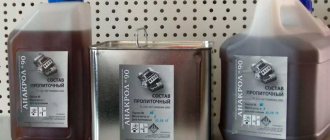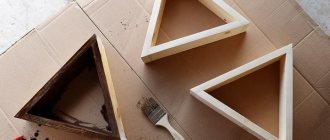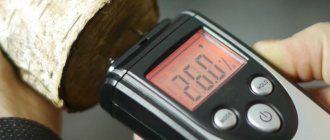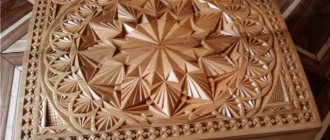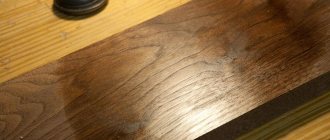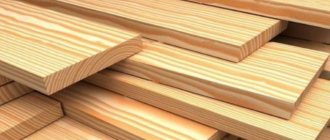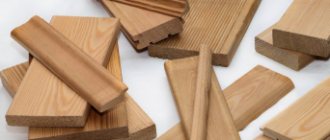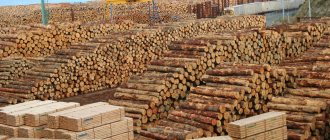Wood defects are structural features, deficiencies that negatively affect the characteristics, limiting the use of the entire trunk and its parts.
Such deviations can manifest themselves in natural changes in the external shape or internal structure of the trunk itself, and there can also be various damage caused by improper preparation and storage. Early detection of defects is very important. Certain types of defects are easily identified by simply examining a tree in the forest. Others, and these are the majority, are revealed after cutting, sawing or processing.
Wood defects and their impact on quality
A detailed description of the defects and a complete classification of all wood defects are described in GOST 2140-81. This regulatory document identifies nine types of defects:
- Bitches.
- Cracks.
- Form defects.
- Defects in the structure of wood.
- Chemical stains.
- Fungal infections.
- Biological damage.
- Foreign inclusions, mechanical damage and processing defects.
- Warped.
GOST 2140-81 Visible defects in wood. Classification, terms and definitions, methods of measurement
1 file 5.21 MB
Defects in the structure of wood are changes in the external characteristics, structure, order of tissues, as well as various damages that affect the mechanical properties of wood, making it difficult to process. They reduce the grade of timber, the quality of wooden products, their cost, and their ability to be stored for a long time without loss. Also, the presence and type of defects influence the processing methods and techniques applied to a particular tree.
The importance of knowing the vices and defects of lumber products
It's difficult to find the perfect looking lumber. But, if some flaws do not particularly affect the performance characteristics of the product, others significantly reduce its strength and quality, limiting the scope of application.
Unscrupulous sellers are common in the market. They offer, under the guise of high-quality lumber, defective and unsuitable products for the required work. Accordingly, they set inflated prices. It is impossible to create a high-strength and durable structure from such a material. Therefore, you need to be vigilant, know the flaws and defects of lumber, their characteristics, impact on strength and other performance properties, and acceptable standards.
Wood structural defects
There are 48 structural defects of wood. Below is a description of wood defects that significantly affect the quality of wood and are the most common:
- Fiber inclination. Mismatch in the direction of wood vessels and the orientation of the main longitudinal axis of the trunk. The angle of convergence (oblique) is determined by the helical arrangement of the fibers around the central axis. There are two types of inclination of wood fibers.
- Tangential tilt. It manifests itself in lumber as non-parallelism of the core rays, resin ducts, and other elements.
Radial tilt. Appears on rounded surfaces of wooden products. Determined by the presence of non-parallel growth rings. It manifests itself in details, veneers made from timber with such defects as bevelling, curvature, and roughness. The reason may be poor-quality cutting of straight-grained wood.
- Kren. Disturbance in the layering of tissues in the area of knots is manifested in an imaginary increase in the thickness of growth rings facing downwards. Inherent in conifers. It is determined visually on log cuts, or on the surfaces of blanks and products. Characteristic are arcuate, annular areas and stripes of a darker shade. The defect is most pronounced in trees that grew obliquely or are twisted.
- Local roll. Or veiny. Arcs, stripes passing through annual rings.
- A complete roll. Spots of continuous darkening, covering more than 50 percent of the area, are located to the left or right of the center of the transverse cut.
- Traction wood. Significant “stretching” of the width of annual increments. Such changes are typical for deciduous trees. Can be identified on a saw cut by locally expanded arcs. In products made from species with clear annual rings (ash, oak), such a defect becomes visible in the radial sections; it can be determined by the presence of strands of conductive tissue.
- Curly wood. It manifests itself in the chaotic growth of its blood vessels. A similar disordered arrangement of fibers inside the wood is often characteristic of the thickened lower quarter of larch trunks.
- Fibrous curliness. Some ordering can be observed in the course of the fibers.
Confused curliness. Wood fibers are arranged completely randomly.
- Curl. It is formed from arcuately curved growth rings. The appearance of such distortions is caused by knots and sprouts. Curls can be one-sided or through, it depends on whether it comes out on one side of the product or on two opposite sides.
- Eyes. An eye is a bud that has not developed into a shoot. There are scattered (more than 1 cm between them) and combined into groups (three or more, with intervals of less than 1 cm). If the eye is painted in a color close to the general tone of the material, then it is called light; if it is more saturated, it is called dark.
- Pocket. Lacunae filled with resin or gum are located between the rings of annual growth.
- Core. The central cord of the trunk is made of spongy tissue with a brown or light color. There can be two cores, then the defect is called “double core”. If the core is displaced from the central axis of the tree, then its transverse becomes oval.
- Dry-sidedness. A section of the trunk that has died for some reason. The dried area has growths along the edges, its surface is depressed relative to the general surface.
- Germination. A wound that has healed or healed. At the site of the wound, a radial cavity remains filled with the remains of dead tissue.
- Cancer. A depressed or, conversely, convex area. Cancer is bacterial or fungal in nature.
- Grinded. An area of conifer wood with vessels filled with resin. The pitch is usually darker than the surrounding tissue.
- False core. It is characterized by uneven coloring, darker than the main background, its border does not follow the growth rings. The hardness of the false core is the same as that of the rest of the wood.
- Spotting. Stains, spots, lines observed in the structure of wood that do not affect the hardness. Characteristic of deciduous timber.
Curlyness
An indicator of this structural defect is a chaotic or wavy arrangement of wood fibers. Any plant can be affected by curling, but more often it occurs with representatives of deciduous species. The presence of this feature cannot be determined by the timber located in the bark.
A section of lumber with pronounced curling
The increased strength of areas with deviations from the straight-layer arrangement of fibers significantly complicates the processing of wood with cutting tools. But the disadvantage can be considered conditional, because products made from materials with grain are not inferior in characteristics to high-quality wood. A vice becomes a virtue thanks to the unique pattern on the surface of a debarked log or sawn product.
The beauty of a debarked log with curling in a chopped interior
Trunk shape defects
GOST defines the following form defects:
- Convergence. Escape is a smooth decrease in the radius of the barrel. Normal escape is a decrease in trunk diameter by 1 cm per meter of its length. If the amount of run-off is higher than the norm, they speak of high run-off.
- Ovality. This defect is determined in timber if the ratio of the smaller and larger cross-sectional diameter of the trunk is less than 1:1.5.
- Growth. Local change in trunk thickness. In the tissues of the growth, relief stains of various shapes are determined.
- Curvature. The degree of deviation of the longitudinal axis of the trunk (lumber) from straight. Practically does not occur in spruces, poplars, oaks, and fir.
Tree species with the least chance of rotting
Larch and oak have great resistance to decay processes. Houses made from them last for centuries and do not rot.
Cedar, ash and Scots pine also have high resistance. Beech, spruce and fir are characterized by average resistance. Destructive microorganisms cannot grow in yew and sequoia wood.
The information obtained about possible negative changes in the integrity, appearance and structure of wood helps to independently reject products before the start of construction and finishing work. The remaining quality lumber will produce a high-quality and durable object or product.
Find out the reason for the hardness of larch and its resistance to decay:
Cracks
Wood cracking parallel to the grain.
Types of cracks:
- Methic. It is located radially from the center of the trunk, extending along its entire length. They can be simple and complex.
- Frosty. It runs along a radius from the sapwood to the heartwood. Appears in living wood at low temperatures. Extended.
- Fuck you. Having arisen in the core, it passes between the layers of annual growth.
- Shrinkage crack. May appear due to poor drying, less extensive than frost and metic cracks.
- Side crack. It extends either only to the side surface of the product, or to the side surface and end.
- End crack. It comes out only at the end, the side surfaces are not affected.
- Shallow crack. For timber: does not exceed 1/10 of the end diameter and 7 cm. For lumber: no more than 5 mm. Doesn't go right through.
- Deep crack. Exceeds the parameters of a shallow crack, not through.
- Through crack. Has two exits.
- Closed crack. Less than or equal to 1 mm.
- An open crack. Its width is more than 1 mm.
Fungus can grow in wood
Fungal lesions are a group of defects that occur with the participation of fungi, which can either cause the destruction of wood or not at all affect its strength, but have the property of changing color.
There are only 6 types of such fungal lesions: mold, mushroom core spots, sapwood mushroom stains (colored spots - dark and light, deep, surface and sublayer), browning (lateral and end), rot and hollow.
Mold appears as a continuous coating or stain on areas of the wood surface. It appears during damp storage of timber and colors the surface of the wood pink, black and other colors, which depend on the color of the mycelium and spores.
Fungal heartwood stains do not reduce the strength of wood; they appear in the core of the tree under the influence of wood-destroying and wood-staining fungi. They are recognized in various forms - rings, holes, a continuous affected area in the center of the trunk, often extending to the periphery.
Sapwood fungus stains are areas of colored sapwood affected by a wood staining fungus that does not cause rot in cut wood. It is noted in the form of stripes, elongated spots or entire surface lesions. These colors are characteristic of coniferous species. Fungi cause blue, greenish or gray coloration. Light colors do not mask the wood texture, dark colors of sapwood paint it in dark tones and mask the texture. Deep sapwood colors penetrate into the texture to a depth of more than 2 mm, and sublayer colors are located at some distance from the general surface.
Browning affects hardwood with a brown color. In felled wood, biochemical processes occur that reduce the hardness of the wood. The brown color during end browning originates from the end and goes along all the fibers. Lateral browning begins from the side surface and spreads towards the center of the timber.
Rot is areas of wood that are abnormal in overall color, which may or may not reduce the hardness of the material, arising from the influence of wood-decaying fungi. The first stages of fungal infection do not change the quality and value of the wood, but only change the color of some areas.
It has several varieties, distinguishable by color and structure: variegated sieve, brown fissured, white fibrous.
The types are distinguishable in the following types: sapwood (soft and hard), external rotten and sound.
Variegated sieve rot is characterized by reduced hardness and variegated color. Such wood retains its integrity for a long time, later it becomes soft and splits. Brown cracked rot causes cracking of the material along and across the fibers. White fiber rot attacks lignin and cellulose and discolors the wood in a marbled pattern. When severely damaged, it easily splits and crumbles.
The type of sapwood rot has pinkish-brown or yellowish-brown hues in softwoods, and a marble-like pattern in hardwoods. The hard type of this rot is close to the same hardness as the surrounding wood. Soft sapwood rot has reduced hardness.
External rotten rot occurs both in the sapwood part of the timber and in the core. This brown, cracked rot occurs during improper and long-term storage under the constant strong influence of wood-decaying fungi.
Core rot occurs in the core of a tree during growth and is characterized by reduced hardness. The first stages of such rot do not affect mechanical performance. Appears in the form of elongated spots or stripes.
Knots on the trunk
A knot is the part of a branch that passes through the trunk. There are many types of knots. They can be classified according to the following criteria:
- cross-sectional shape (a knot in cross-section can be round, oval, oblong);
- exit location (exit is located in the edge, rib, end of the product, or in a layer of material);
- location relative to each other (separately scattered, collected in groups);
- connection with surrounding tissues (branched, partially or completely fused, unfused, prolapsed);
- condition (healthy, decayed, rotten, tobacco);
- number of exposures to the surface of a product or material (one-sided, through, overgrown)
General description of defects
First, it’s worth understanding what, in principle, is classified as a wood defect. These are various kinds of defects that arise on the material due to exposure to weather conditions, mechanical forces, the presence of biological pests or any other factors.
It is also worth noting that these flaws do not always need to be eliminated, it all depends on the purpose for which the material is used. Of course, in woodworking such defects impair the quality and complicate the processing process. In wood carving, for example, some flaws do not interfere with the work at all, but according to artistic intentions they can also be part of the pattern.
For these reasons, any person who plans to work with wood needs to know what defects the material may have, which of them are dangerous and which are not. First, it’s worth understanding the general classification of wood defects:
- knots and cracks;
- defects in the shape and structure of the trunk;
- biological and fungal defects;
- foreign inclusions or chemical coloring;
- mechanical damage, warping, etc.
It is important to note here that mechanical defects include not only those that the tree had initially, but also those that may arise during processing, transportation, sorting, etc.
Defects from pests and fungal infections
Biological damage occurs as a result of the activity of living organisms.
Timber is attacked by a variety of animals and plants belonging to various classes and orders. Such damage can render the timber completely unusable.
Defects resulting from the activity of animals and plants:
- Wormholes. Passages, holes left by insects and their larvae.
- Damage from parasitic plants.
- Damage by vertebrates. Hollows left by birds, defects left by mammals.
Fungi cause many defects. The most common are:
- Mold. Superficial mold stains, mold deposits.
- Spots and stripes. Caused by the activity of fungi in uncut wood.
- Sapwood coloring. Appears in an already cut trunk, the hardness is not affected, only the color of the plant tissue changes.
- Browning. Brown spots and stripes in deciduous wood appear after cutting. They slightly reduce the hardness of the material.
- Rot. Manifestation of fungal activity that destroys the structure of the tree. Significantly reduces hardness.
- Hollow. A cavity formed in a growing tree due to local tissue destruction.
Pests
The wood of any tree is threatened by both insect pests and plant microorganisms, which include colonies of fungi. Insect pests can attack both growing trunks of different tree species, as well as already harvested lumber, as well as products made from them.
For the tree, it is mostly not the adults themselves that are dangerous, but their larvae, which these insects deposit in the tree bark and crevices. After hatching from the eggs, the larvae begin to move in different directions and dig passages for themselves, called wormholes.
These same wormholes do not have the best effect on the condition of the wood and reduce its practicality of use to two points.
The most common insect pests of wood include:
- Brownie barbel. This beetle prefers to lay its eggs in dry coniferous wood.
- The false bark beetle can cope with even the hardest types of wood. This beetle gnaws while walking along the wood fibers and prefers to settle in lumber that has not been treated with an antiseptic.
- The weevil beetle infects the trunks of fruit trees and can also live and reproduce in dried and rotten trees.
- The boring beetle prefers coniferous trees, oak or walnut. Its larvae break through passages several millimeters in diameter, after which the mycelium necessary to feed the drillers grows in them.
- The grinder beetle is the most common type of pest. It lives both in the trees themselves and can settle in almost all wooden products.
Insect pests can be detected in harvested tree trunks, lumber and in the walls of a wooden house using a special acoustic device.
Warped
Warping of wood, that is, a change in its shape, occurs during its processing, drying, and storage.
Methods for measuring warp in lumber:
- The longitudinal types of warping and the transverse type of warping are determined by the magnitude of the deflection of the material.
- Winginess is determined by the highest deviation of the surface from the general plane.
- Complex warping is determined by the magnitude of the deflection of the largest curvature entering it.
Some wood defects are determined visually, but most accurately and correctly they are detected and measured using hardware methods. Currently, gamma flaw detection, photoelectric, magnetic, X-ray, and acoustic methods are used for these purposes.
Author: Alexander Lugovoy, timber harvesting specialist
Wood defects
- these are specific properties and defects of wood that impair its grade and limit economic use.
Natural vices
appear when the tree matures due to deterioration of growth conditions (climate, soil), accidental defects, natural wilting, as well as the activity of microbes and bacteria, wood-boring beetles and birds.
When determining the quality of wooden assortments, the following defect characteristics are taken into account:
- Type
- Size and extent of lesion
- Placement on logs or round timber
Based on the characteristics of the defect, it may not be taken into account, as well as reduce or increase the quality of the material (desirable defects that are used in decorating wooden products).
Unconditional defects are considered to be those defects that significantly reduce the strength of the wood (rotting, large cracks, violation of the integrity of the trunk when colliding with foreign objects or breaking off, etc.).
To determine the type and degree of manifestation of a defect, along with visual inspection, electrical, magnetic and sound flaw detection techniques are used.
Wormholes and tars
Eliminating wood defects such as wormholes and tar marks is also possible. As for the first problem, these are the passages that wood-boring insects make in the massif. It is quite easy to detect their activity, since small holes will be visible on the surface.
The whole problem lies in the fact that the damage can be minor and then it does not interfere with the work in any way, but it can be quite serious, which will lead to the complete rejection of such a workpiece. Only a professional can determine what type of damage. If such holes are found in lumber blanks, then it is better not to buy them at all. If they are found in the walls of, for example, a wooden house, then you must immediately call a specialist who can treat the structure with good antiseptics. You cannot delay this, as these insects multiply very quickly.
Tarring most often occurs in places where the wood has been damaged by a tool. This greatly reduces its strength and impairs performance characteristics. There is no way to get rid of this shortcoming once it appears. This means that you need to be careful when processing wood so that they do not appear at all. This will be the best solution.
First type of flaw: knots
First you need to decide what it is. Knots are parts of branches, or rather their bases, enclosed in wood. However, not all so simple. Today, seven different types of this deficiency are known. Types of wood defects:
- The first type is distinguished by its position. They can be face-on, that is, extending onto the face of a board or timber. They can be edge, that is, located on the edge of the board, or they can also be edge or end. If the cross-section of a knot goes through the entire cavity and is present at two ends at once, then it is stitched.
- Naturally, they can differ in their shape. There are round, oval or oblong.
- The degree of overgrowth also differs. They can be either overgrown or open.
- The degree of fusion is also highlighted separately. They can be either completely fused or partially fused. There are also drop-down types. This means that the knot is practically not connected to the surrounding wood.
- They can also be one-sided or end-to-end.
- Depending on the condition of the wood, the condition of the knots also changes.
Defects and defects of wood are the worst enemies for the quality of lumber. Sometimes knots are quite difficult to identify. For example, the horn type is distinguished by the fact that the tree itself is healthy, but some areas are heavily impregnated with resin and tannins. Because of the resin, they have a darker color as well as increased strength. However, if you dry a product with such a flaw, the knot will simply fall out and a hole will form.
There may also be weakened knots. This means that the tree around them is still healthy, but they themselves are already starting to rot. At this stage, the knot may still be quite hard and retain its structure, but its color has already noticeably changed. A loose type of knot means that the material around is healthy, but a certain area has either completely or partially lost its structure and is already too soft. The last type is a tobacco knot that has completely lost its hardness and structure, acquired a rusty-brown color that resembles tobacco and almost immediately turns into powder when touched.
- 1. Knots, cracks
- 2. Defects in the shape of the trunk
- 3. Defects in the structure of wood
- 4. Fungal infections
- 5. Chemical stains, biological damage and warping
- 6. Foreign inclusions, mechanical damage and defects in machining
LECTURE No. 2. Types of wood defects
1. Knots, cracks
Wood defects
- these are deviations from the norm in the structure of the trunk, all violations of the physical condition. Defects include: knots, cracks, defects in the shape of the trunk, wood structure, chemical stains, fungal infections, biological and mechanical damage, processing defects and warping.
The most common defect is knots
– the bases of the branches that are present in the wood of the trunk.
When cutting wood, knots of different shapes and types are revealed on its surface. Based on the shape of the cut on the surface of the wood, you can see round, oval and oblong knots, and according to the degree of fusion with the wood, they are further divided into fused, partially fused and unfused, or falling out. When cutting wood into boards, knots can have different positions - face, edge, edge, stitched
- in the case of a longitudinal section of a knot, part of it extends simultaneously onto two edges of the same side of the board and
end
- when the knot is at the end of the board.
According to the relative position of knots on lumber, they are divided into scattered
- single or spaced at a considerable distance from each other, group and branched.
According to condition
The wood of the body of the knot itself is divided into: light healthy, dark healthy, healthy with cracks, rotten, rotten and “tobacco”, in which the rotten wood is completely or partially replaced by a loose mass of rusty-brown or whitish color. The presence of knots in wood leads to a decrease in strength, complicates its processing and gluing, and reduces quality (especially when their number and diameter are large). Unfused and rotten knots significantly reduce the quality of wood, and in some cases they make the wood unsuitable for making products (for example, boards).
Another type of wood defect is cracks,
formed when wood breaks along the grain. Cracks occur in growing and felled trees. The first ones include metic, peeling and frost cracks, the second ones include shrinkage cracks.
Methic cracks have the greatest extent, which pass through the core of the tree trunk, and when the harvested wood dries, their size increases. In round pieces of wood, such cracks usually occur at the ends; in lumber or parts - at the ends and side surfaces.
When wood delaminates along the annual layer, peeling cracks form, usually at the border of a sharp transition from interlayer wood to large-layer wood, and are found in trees of all species. During drying of wood, the peeling crack increases.
When drying wood under the influence of internal stresses, shrinkage cracks appear.
This type of cracks differs from others (metic and frost-breaking) in their shorter length and depth.
In boards, cracks can extend to the face, edge or end. Accordingly, they are called face, edge and end. Cracks, especially through ones, violate the integrity of the wood material and reduce its mechanical strength.
2. Defects in the shape of the trunk
Processing of wood of all species is very often complicated by the presence of defects in the shape of the trunk: camber, ovality, growths, curvature and burrowing.
Convergence
is expressed in a decrease in the diameter of the log or the width of the unedged board, exceeding the normal run-off, which is equal to 1 cm per 1 m of the length of the assortment.
As a rule, it is greater in deciduous trees, especially in trees that have grown in open spaces, and along the length of the trunk - in the apical part. This type of trunk shape defect increases the amount of waste when sawing and peeling round timber and causes the appearance of radial inclination of fibers in the veneer. The ovality
of the trunk is an ellipsoidal cross-sectional shape of the end, whose larger diameter is 1.5 or more times larger than the smaller one.
Wood processing is complicated by growths in the form of local thickening of the trunk of various shapes and sizes. Growths
are formed as a result of tissue growth under the influence of various irritants - fungi, low or high temperatures, etc., as well as fires, mechanical damage and other reasons.
Rice. 2. Growths: a) smooth, b) lumpy
Smooth growths (Fig. 2a) often appear on pine and birch trunks. The annual layers in places of growths are usually wider than in the trunk. Lumpy growths, or burls (Fig. 2b), are formed mainly on the trunks of birch, walnut, as well as maple, black alder, ash, beech, poplar, etc. The wood in the burl zone has an irregular structure with a curled-wavy direction of the fibers and with dark-colored inclusions in the form of small spots, dashes and dots. When cut, burls have a beautiful texture, so they are used as a material for artistic crafts and the manufacture of sliced veneer.
Such a defect of the trunk as its curvature,
also makes it difficult to use round timber and increases the amount of waste during sawing. The curvature of the trunk is the deviation of the longitudinal axis from a straight line, and it can be with one bend or complex - with two or more bends.
Often there is a type of trunk defect such as lumpy,
which is expressed in a sharp increase in the diameter of the butt part of round timber, i.e. when the diameter of the butt end is 1.2 times greater than the diameter at a distance of a meter from this end. When sawing and peeling wood, the presence of such a defect leads to an increase in the amount of waste and, in addition, causes the appearance of a radial inclination of fibers in the veneer. The hardness of the round timber also makes it difficult to use round timber for its intended purpose and complicates wood processing.
3. Defects in the structure of wood
When processing wood, defects in the structure of wood often occur due to the incorrect structure of the trunk. There are the following types of structural defects in wood:
1) cross-layered,
or fiber inclination, which is the deviation of the fibers from the longitudinal axis of the trunk;
2) list
– continuous or local in the form of a sharp thickening of the wood of the late annual layers;
3) curliness
– sharply wavy or confused arrangement of wood fibers (wood blanks with such a defect are used in the manufacture of art products, furniture, axes and various crafts);
4) curl
– local curvature of the annual layers near knots or sprouts (wood with such a defect is used in furniture production and arts and crafts);
5) resin pockets.
Found in coniferous wood, especially spruce, they are cavities between the annual layers filled with resin;
6) tarred
– a section of coniferous wood, richly impregnated with resin;
7) double core
– two cores in one cross section of the log, which are formed at the bifurcation of the trunk;
 stepson
stepson
– stunted and dead second apex, which is usually located at an acute angle;
Rice. 3. Defects in the structure of wood: 1 – types of fiber inclination: a – tangential inclination in round timber; b – local; 2 – heel: a – solid; b – local; 3 – fibrous curling in birch; 4 – one-sided curl; 5 – pocket; 6 – double core in a pine trunk; 7 – stepson; 8 – dry side; 9 – pine cancer; 10 – germination: a – open; b – closed; 11 – false nucleus: a – rounded; b – star-shaped; c – lobed
9) dry side.
Occurs as a result of damage to the bark of a growing tree in the form of a dead section of the trunk;
10) germination.
It is an overgrown wound, usually filled with remnants of bark and dead tissue;
11) cancer,
which is a wound of a tree and occurs on the surface of the trunk as a result of the activity of parasitic fungi and bacteria, while the structure of the wood and the shape of the trunk change;
12) false core
which resembles a real core, but differs in a more heterogeneous structure and less regular shape, stands out as a dark, unevenly colored zone in the central part of the trunk, is separated from the sapwood by a dark and sometimes light stripe, appears from the effects of fungi, severe frosts, as a reaction to wounds and for other reasons, while the wood of the false core is more fragile and less durable, and the appearance is usually worse;
13) internal sapwood
– the presence of several annual layers in the heartwood, which are similar in color and properties to sapwood, and it has reduced resistance to decay and increased permeability to liquids;
14) watershed
– wood defect in the form of areas with high humidity as a result of the action of bacteria, fungi, penetration of rainwater through wounds or from oversaturation of the soil with moisture.
4. Fungal infections
When cutting wood, in some cases, mushroom core stains
– abnormally colored areas of the kernel that are formed in growing trees under the influence of wood-staining or wood-destroying fungi. In felled wood, further development of this defect stops. Fungal core spots are observed on the ends in the form of spots of various sizes and shapes of brown, reddish-gray or gray-violet colors. This defect causes: a decrease in impact strength, an increase in water absorption and permeability, a deterioration in the biostability and appearance of wood; the strength under static load remains almost unchanged, and the structure of the affected wood is preserved.
When storing wood on damp sapwood, mold often appears - mycelium and the fruiting of mold fungi on the surface of the wood in the form of separate spots or a continuous coating, and the wood is painted in different colors. Mold does not affect the mechanical properties, but deteriorates the appearance of the wood; after drying, it is easily removed, leaving dirty and colored spots.
Sapwood fungal stains often form in felled wood
– abnormally colored areas of sapwood under the influence of wood-destroying fungi that do not cause the formation of rot. Sapwood mushroom stains do not affect the mechanical properties of wood, but worsen its appearance and increase water resistance. By color, blue is distinguished - in the form of a gray color of sapwood with bluish or greenish tints and colored sapwood spots - in the form of orange, yellow, pink and brown color of sapwood. Fungi that stain sapwood can destroy glue and paint finishes.
In felled wood, when stored in the warm season, as a result of the development of biochemical processes with or without the participation of fungi, a defect such as browning occurs.
Browning of wood appears in the form of abnormally colored areas of hardwood of various shades of brown. Browning is observed on the ends in the form of spots of various sizes and shapes, and on the side surfaces - in the form of elongated spots, stripes or complete damage to the sapwood, while the appearance of the wood deteriorates and the strength and hardness are slightly reduced. To prevent browning of wood, lumber is steamed.
Rot causes great damage to wood
formed under the influence of fungi. Rot is distinguished by the color and structure of the lesion - variegated sieve, white fibrous; and also by type - sapwood, soundwood and external rotten.
Wood affected by rot is a source of fungal infection for various wooden structures. Rot
develops gradually and has three stages: in the first, only the color of the wood changes; on the second, the wood partially changes structure and hardness under the influence of rot; on the third, the wood completely loses its strength and hardness. Depending on the stage of development of the rot and the size of the lesion, the quality of the wood can significantly decrease.
5. Chemical stains, biological damage and warping
In the process of wood processing, a phenomenon such as chemical coloring of wood is often encountered - abnormally colored areas in cut wood that arise as a result of chemical and biochemical processes.
In most cases, it is associated with the oxidation of tannins. Typically, such areas are located in the surface layers of wood - at a depth of 1–5 mm.
As the practice of wood processing shows, chemical stains only change its color and shine, while the other properties of wood remain unchanged. With intense natural coloring, the appearance of the wood deteriorates, but as it dries, chemical coloring gradually fades.
If the technology for storing freshly cut timber is violated, the wood is subject to biological damage
in the form of wormholes - passages and holes made in wood by insects and their larvae (beetles, butterflies, termites, etc.). The optimal living conditions for these insects are a temperature of +18–20 °C and a relative air humidity of 60–80%. Wormholes vary in penetration depth: superficial (no more than 3 mm deep), shallow (no more than 5 mm in round timber and no more than 5 mm in lumber) and deep. Moreover, they can be non-through and through, i.e., extending onto two opposite sides of the board.
A superficial wormhole does not affect the mechanical properties of wood, but shallow and deep ones violate the integrity of the wood and reduce the mechanical properties.
During long-term storage in violation of technology, a so-called rotting wormhole can form in the wood, which is caused by house pests that can develop on dry wood - furniture and house grinders, house beetles, termites. In this case, the number of deep passages is large, and the wood inside them turns into a rotten mass with a high content of drill flour.
When drying or moistening, as well as during mechanical processing, as a result of anisotropy of shrinkage - swelling and internal stresses in wood - a phenomenon such as warping
in the form of a change in the form of the assortment. Warping of lumber can be of different types: longitudinal along the face, complex, longitudinal along the edge, transverse, and also like a wing (wing-thickness) (Fig. 4). The nature of the warping depends on how it was cut from the log. Warping reduces the quality of lumber and wood products, complicates processing and cutting, increases the amount of waste and generally makes it difficult to use wood.
Rice. 4. Types of warping: a – transverse across the face; b – longitudinal along the surface; c – wingedness
The phenomenon of warping is most often observed in lumber obtained by processing birch.
6. Foreign inclusions, mechanical damage and defects in machining
In some cases, during the processing of wood, foreign inclusions are discovered in the form of a foreign body of non-wood origin - a nail, wire, metal splinter or stone.
An external sign of such a defect may be local swelling and folds of bark in the wood, a dent, or a hole. Such inclusions complicate the mechanical processing of wood and often cause damage to cutting tools - milling cutters, circular saws, cutters, etc.
Mechanical damage and defects in machining can be of different nature and different origins.
Sometimes you come across charred wood. Charring of wood is the result of damage by fire, changing its shape, making it difficult to use and causing loss of wood.
Carra
– this is damage to the trunk during tapping, which causes tarring of the wood.
Obzol
is a part of the side surface of a log that has been preserved on an edged board or piece, which reduces the actual width of the board and makes it difficult to use.
When processing wood with cutting tools, risks
on its surface,
waviness
is a non-flat cut or irregularities in the form of arched elevations and depressions as a result of cylindrical milling of wood.
Poor-quality wood processing leads to the appearance of surface hairiness in the form of the presence of incompletely separated fibers and mossiness - the presence of tufts of incompletely separated fibers and small wood particles. Zarub
– local damage to the wood surface with an ax.
A cut
is local damage to the wood surface with a cutting tool (saw).
During the harvesting and processing of timber, flakes
- side cracks extending from the end of the round timber.
During similar work, breakouts
- depressions with uneven surfaces as a result of local removal of wood under the influence of tools or mechanisms.
When processing wood with a cutting tool against the grain, various mechanical grips are often observed, which leave dents
- depressions on the surface formed as a result of local compression of the wood, as well as
scratches
- damage to the surface in the form of a narrow long depression.
As a result of the chipping of the cutting edge of the tool, scallops
– areas of the untreated surface in the form of a narrow strip protruding above the treated surface.
When sanding the surface of wood, sometimes a defect occurs such as sanding
– removal of part of the wood below the level of the treated surface.
With increased friction of cutting tools during wood processing, a defect such as a burn
wood in the form of a darkened area of the treated surface.
The above wood defects reduce the quality of processing, affect gluing, finishing and veneering of the material or the entire product, in some cases worsen the appearance and violate the integrity of the wood, impair mechanical strength and complicate use.
Table of contents
